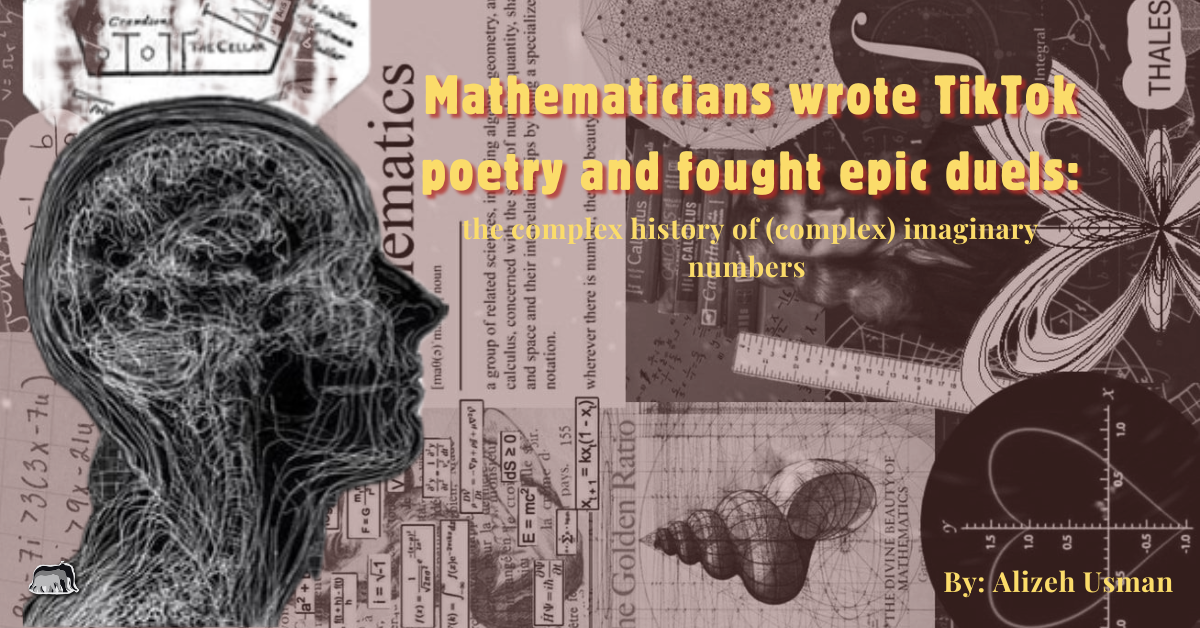Why did mathematicians invent imaginary numbers?
Was a question that kept lingering in my brain, tormenting and taunting me with its hows and whys. Everyone around me—certainly not I—dreamt of love, success, money, and that is what an immense proportion of their daydream imaginations usually consisted of. Hence, excuse me for being perplexed and livid at the notion of mathematicians conjuring up imaginary numbers, not imaginary lovers or friends that any normal human would be expected to do so (again, certainly not I). As far as I could recall, homo sapiens did reside in a real 3-dimensional plane, with real calculations and proportions that would require real numbers, right? Putting my Sherlock hat on, I took the case in my study to research this peculiar concept and thus began my hyperfixation on complex numbers.
In the earlier civilizations, mathematics was not inscribed down in equations, but rather in words and geometric pictures. Take this simple quadratic equation for instance:
x2 + 24x = 27
The squared X was considered as an actual square with sides X cm. The 24x was a rectangle with sides 24 and X. To find the value of X, the 24x rectangle was halved into two smaller rectangles of sides 13 and X. These small rectangles were then placed side by side to the original X square and made into a shape that seems like a square with a missing part. The missing part appears to be a square with sides 13. In order to complete the square, you add (13 * 13) to both sides. And the rest remains history.
Presumably, all that calculation went over your head and perhaps even induced PTSD symptoms inside you. Hence, to cut it short, we get the answer x= 1. As true as it is, what about the negative answer 27 that one would be expected to attain through the classic quadratic formula?
For mathematicians that perceived these problems as geometric shapes, the idea of a side length of a square being negative was as daft as Neitzche hosting a podcast on happiness and motivation. It was simply unpragmatic and impossible. What’s even more unfathomable for 21st century folks like us is that there existed no single quadratic equation with negative quantities or coefficients because mathematicians were allergic to negativity (no pun intended).
400 years later, a maths professor with a complex (pun intended) name discovered a method to solve a subset of cubic equations. And what do you think he did after cracking a conundrum that had been declared unsolvable by Leonardo Da Vinci’s maths teacher, one which had troubled mathematicians for over a millenia? He did what any sane person would do. He didn’t tell anyone.
Being a mathematician in the 1500s was no different than being a boxer who could be challenged by any newbie to a match. Any promising mathematician could challenge you to a duel at any point of your career, which could either tarnish or augment your reputation forever. Therefore, this cubic-solver mathematician did the only thing he could do to protect his image: concealed his work for nearly two decades. Only on his deathbed did he reveal his work to his student. His student, Antonio, embodied the true spirit of a condescending and pompous jerk. Advertising the work as his own and speaking highly of himself, he challenged another deftful mathematician, Niccolo Fontana, to a maths duel. Following tradition, both passed each other a set of thirty problems to decode. Antonio, being the delusional person he was, underestimated his opposition and handed Fontana questions that were all cubic equations. The ground was (probably) pulled from beneath his feet when he couldn’t solve a single problem from the ones he was given, while Fortana managed to crack each and every one of them in mere two hours.
Fontana, better known as Tartaglia, became the second human on the planet to solve the depressed cubic. His methodology was, in summed up technical terms, to complete the square in 3 dimensions instead of 2. He used the very applications used to solve quadratics while adding into them a series of new steps, more fitting for the cubic equations, out of the genius of his mind. In order to save himself the time needed to perform lengthy steps, he decided to mold his methods into one single piece of data. Now, fellow 21st century homosapien that is reading this, what in your common sense is the most normal and expected way to compile extended computations into one single work? Formulas, right? You would predict him to follow the same train of thought as other renowned (and dead ) scientists did, right? But, reader, what do you suppose Fontana could even do to deviate from the most salient path of compiling? Certainly, out of the very quirky approaches that he had the propensity to undertake, he couldn’t have consolidated the work that could change the history of mathematics into a poem, right? That would be absurd, right? Absolutely ludicrous, right, fellow human?
Well, he did.
By no means was Fontana’s poetic technique astounding or even in any proximity to John Donne or any other esteemed poet of English Literature. In fact, I would even go as far as to draw parallels between his poetry and the most prized aptitude of Gen Z: tiktok poetry. How lovely that is. However, one cannot deny the value of the intellect residing in it and, to be quite honest, the poem itself isn’t too tragic-sounding. It begins with the lines of:
When the cube and the things together
Are equal to some discrete number,
Find two other numbers differing in this one.
Then you will keep this as a habit
That their product should always be equal
Exactly to the cube of a third of the things.
And then it stretches to infinity, so I would recommend you search it up on your own account. The imperative element to note down is that he did not publish this poem publicly. Mathematicians from all over the world were yearning to get their hands on his methodology, but he denied anyone the copy of it. Gerolamo Cardano was one of them who after repeated urgings managed to get Fonata to reveal it to him. Driven and ambitious, Cardano managed to discover a full solution to the cubic equation to cover the leftover unknowns. Bound by an oath Fontana made him take to never publish the cubic solutions, Cardano could not speak of it to anyone. Until, not long after, he stumbled upon the book left by the complex-named Mathematician that revealed his work on his deathbed. The cubic solutions incorporated in that book preceded Fontana by decades and that gave Cardano a loophole which permitted him to break an oath without seeming like a jerk.
Fontana was not at any instance exhilarated by his publication of the solutions. He went as far as to declare Cardano:
“A man of no substance. A very stupid man. An ignoramus in mathematics matters.” The most depressing part about the depressed cubic solutions is that most credit is given to Cardano and not the man that rightfully deserves it. Even ChatGPT believed Cardano to be the poet of the literary mathematics masterpiece until I corrected its illiterate and outdated knowledge of such indispensable subjects. Ladies and gentlemen, the artificial intelligence that will leave humanity unemployed and stupid.
Moving on, Cardano found that the completing square method of quadratics led to a paradox. He somehow happened to add a negative area to the square and it leads him to more perplexing paths. Conclusively, he declared the idea of negative square roots futile and useless. But, ten years later, this is not the same belief that an Italian engineer Rafael Bomballi held as he somehow managed to consider the square roots of negatives and even established them as an individual number. This new-type of number is no other than the one that becomes nightmares of all mathematics students: i.
Time passed, and mathematics transformed from mere geometry to algebra. Rene Descartes popularized the use of these new-type numbers and named them imaginary numbers. It was followed by Euler giving it the symbol that we now know it as (i). Real numbers and these imaginary numbers in amalgamation made complex numbers.
Fast forward to 1925, the legendary physicist who is known to have his cat confined in a box to see if it can be both dead and alive (for legal reasons, that is a joke. A very exaggerated, stupid and prone to offending many physics nerds kind of joke. Spare me some mercy) was looking to create a wave equation. Erwin Schrodinger ultimately concludes the equation that becomes the most valued possession of all physics: The Schrodinger Equation. What frustrated every physician was why imaginary numbers were a part of that equation that also formed the basis of all fundamental physics. Until it became clear that this equation that revealed to us the behavior of atoms proved that our reality deals with complex numbers. Imaginary numbers. Numbers that perhaps exist in dimensions and planes that are incomprehensible and impossible to be perceived by the human eye. One conclusion you can most definitely derive from this is that only by discovering mathematics’s connection to reality can you decipher the true nature of reality itself. Majority of this article was inspired by the video How imaginary numbers were invented by Veritasium and I highly recommend checking that video out for a more detailed and objective history of this subject.
By Alizeh Usman
Writer (Team 2024-25)

